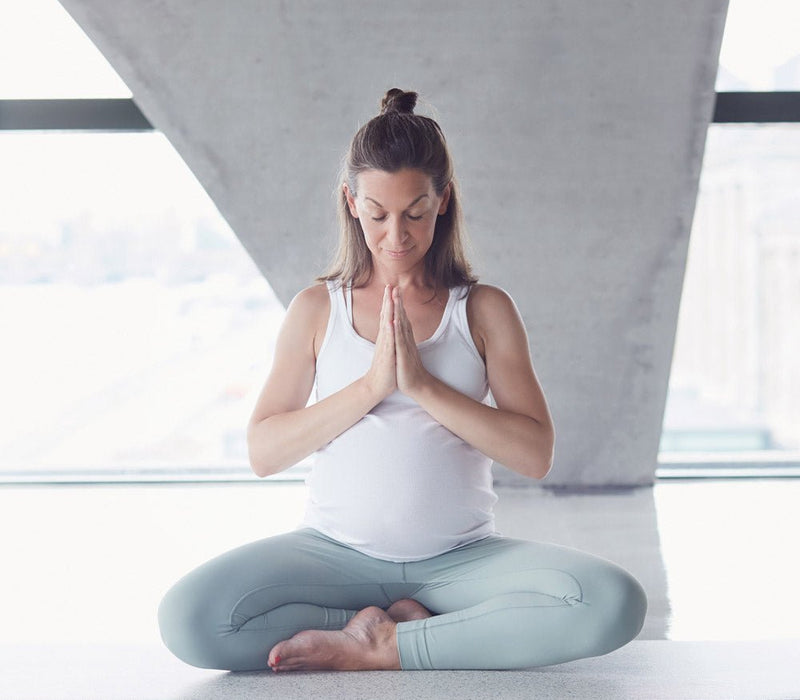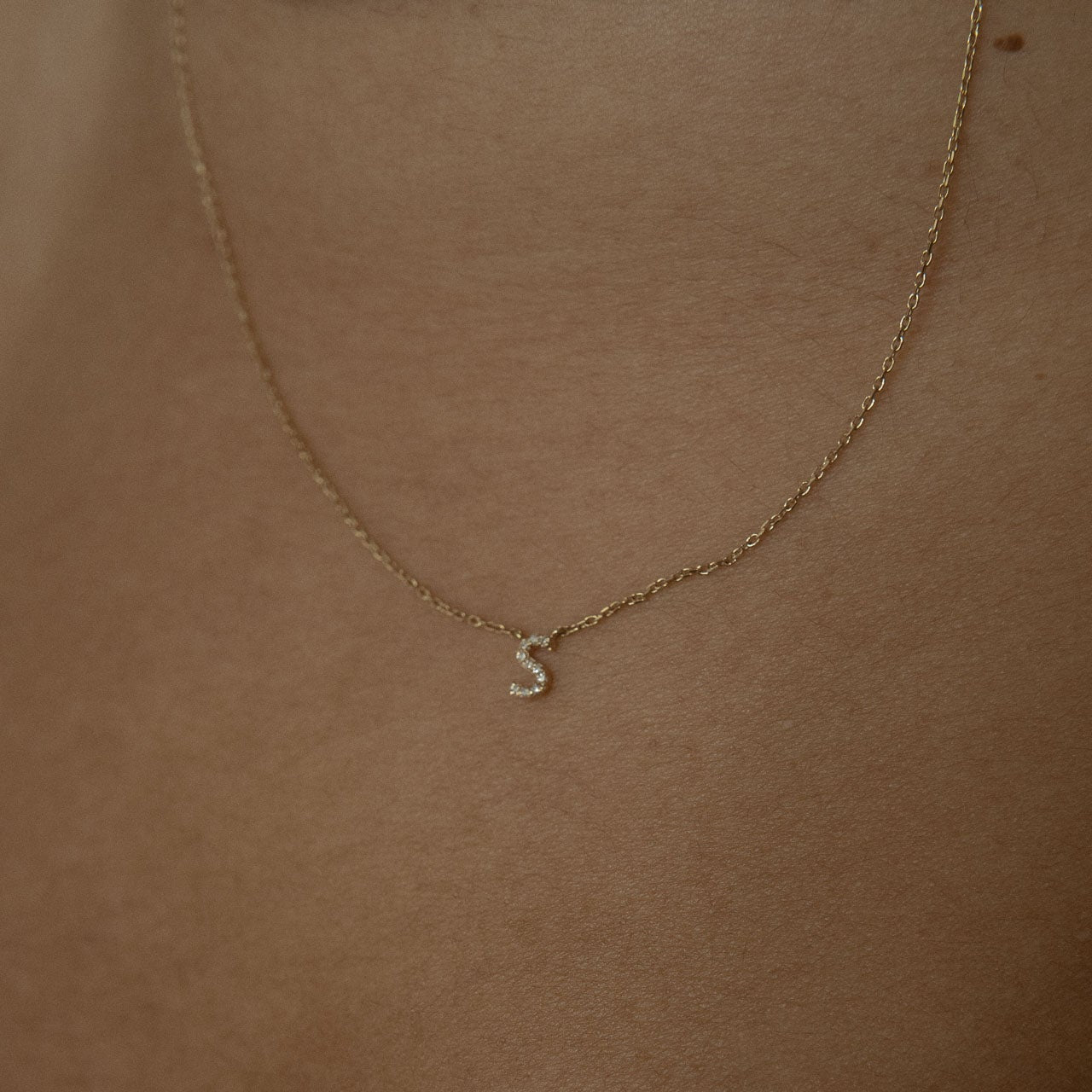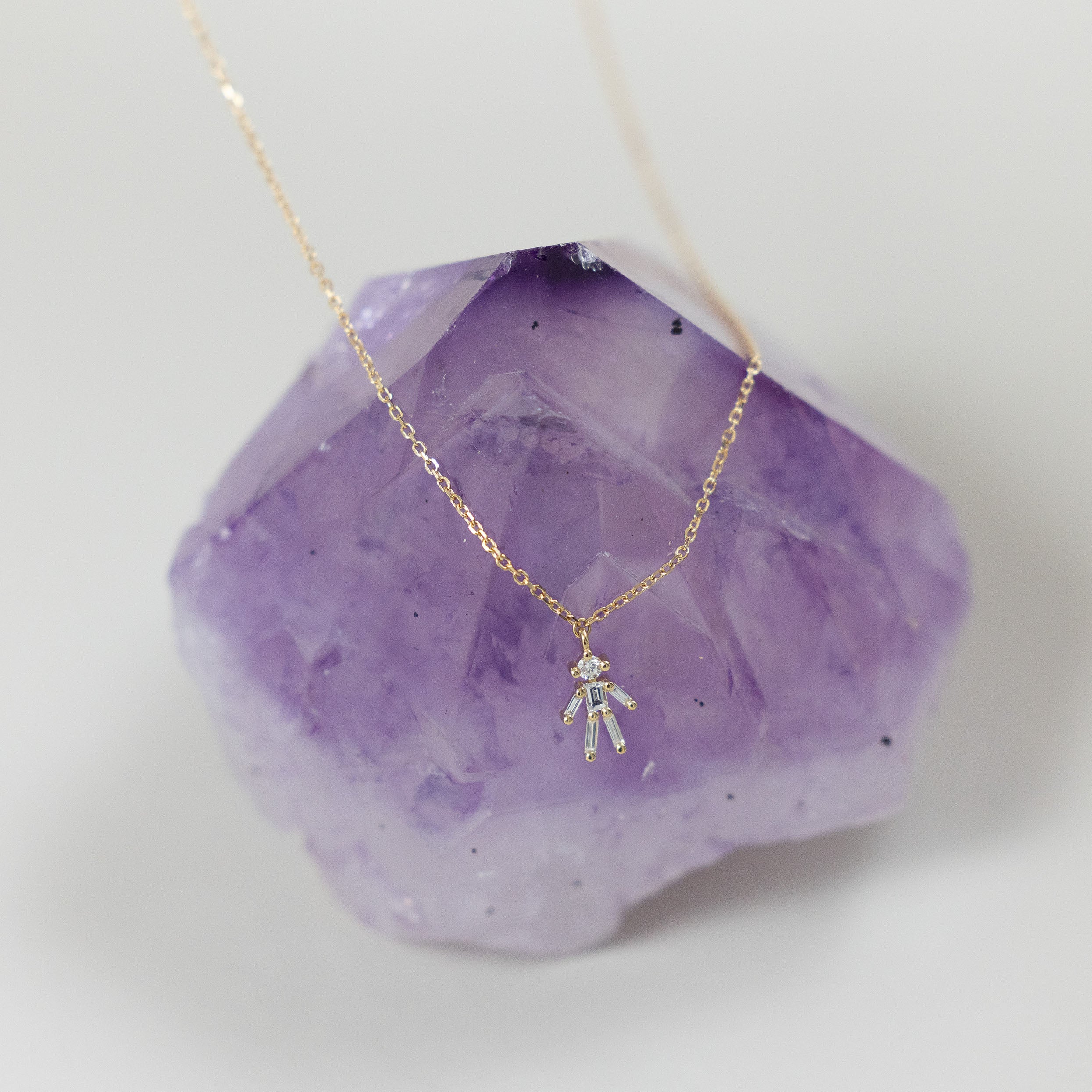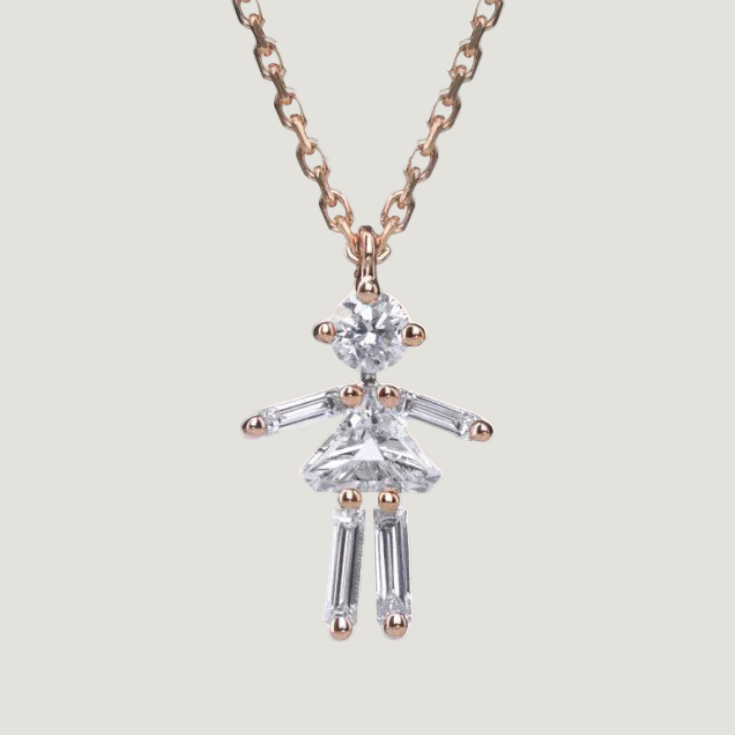"I'll only need rehabilitation and pelvic floor training after giving birth." -unfortunately a sentence that I hear from too many mothers.
However, studies show that pelvic floor training during pregnancy results in fewer injuries and faster birth phases. And who wouldn't want that?!
Also, there are so many potential discomforts experienced during pregnancy that pelvic floor exercises can alleviate. To name just a few: incontinence when coughing and sneezing, symphysis pain, SI joint problems, back pain, and haemorrhoids.
Your body's pelvic floor works together with the deep abdominal muscles, the deep back muscles, and the diaphragm. If one of these systems is disrupted, this also affects the rest of them. Your body has to adapt to a changed hormonal balance, the growing weight on your abdomen, and all of the other static changes that go along with pregnancy for 40 weeks. Most of the time, your body can compensate well. However, if you're experiencing pain, you should make exercise to combat the cause of it a priority.
Pelvic floor training is not just training for your muscles. In this kind of training during pregnancy, we will also focus on learning to relax the pelvic floor. This is to prepare your body for giving birth. The pelvic floor needs to relax when the uterus contracts so that the baby can move.
The training will not only include how to contract and relax these muscles, but will also address other priorities. Posture training, fascia training, breathing, core training (torso capsule), and learning everyday tips should round off the training units.
By actively working these muscles, often overlooked during pregnancy, they become more pliable, flexible, and well-perfused. This heightened readiness can result in a reduction of birth-related injuries.
After delivery, you'll be able to swiftly engage these muscles since you're already familiar with their location and how to manipulate them accurately. Consider this: when you flex your biceps, your arm naturally flexes, but can you truly sense the contraction of your pelvic floor in the same way?
So, find an experienced trainer and get down on the mat
Loosening of the symphysis during pregnancy
Lots of us experience it, but only a handful of us openly discuss or realize that there's something we can actually do about it – I'm talking about when the symphysis starts to loosen. Most of the time, we only become aware of the symphysis issue when we face the discomfort of a growing belly during pregnancy. It's that awkward sensation of pulling in the pubic region, which can get so painful that simple things like walking, putting on shoes, or even going up stairs become quite a challenge.
Where and what is the symphysis?
Our pelvis not only protects some of our internal organs and enables us to walk upright, but it is also particularly important during pregnancy and childbirth. It consists of a ring of bones and the pelvic floor muscles. The pelvic ring also has three joints: the two sacroiliac joints and the symphysis, also known as the pubic symphysis.
The symphysis connects the left and right pubic bones via cartilage.
This usually doesn't allow for much flexibility in the pelvic ring. During pregnancy, however, the female body produces more of the hormone relaxin to prepare for the upcoming birth. This in turn makes the tissue softer and the ligaments more elastic - especially in the area of the symphysis, but also in the sacroiliac joints between the ilium and sacrum. This is normal, but it can be painful if the pubic symphysis dilatation becomes too intense. That's when you hear about symphysis loosening.
The reason behind your symphysis loosening lies in hormonal changes. But it's not just about hormones – it could also be connected to an excessive strain on the expectant mother, and this strain doesn't always need to be physical.
Additionally, a loosened symphysis can be made worse by unnoticed structural injuries from previous pregnancies or incomplete healing, which contributes to overall instability in the pelvic area.
Symptoms that may be related to a loosening of the symphysis
The pubic bone area hurts, sometimes accompanied by pain that radiates from the back into the lateral thighs or inner thighs.
Normal walking causes difficulties. The typical waddling gait of pregnant women is usually attributed to a loosening of the symphysis. The feet are automatically rotated outwards to make walking more bearable.
Standing on one leg is painful and often barely possible.
The lumbar region is painful (because the sacroiliac joint also becomes unstable). Lying on your side is very uncomfortable without a pillow between your knees. Some women report that turning over while lying down is associated with pain.
Getting up (out of bed, out of a chair, out of the car, etc.) can be challenging.
A loosening of the symphysis during pregnancy is painful to varying degrees. For some women, the pain occurs only sometimes, while others report major problems and limited mobility over a longer period of time. As always, every woman and every pregnancy is different. In the event that you experience symptoms, you should consult with a doctor or midwife to take measures to relieve pain as early as possible.
How can you relieve the symptoms?
Regardless of the reasons for the symptoms, a loosening of the symphysis is always a signal from your body. It's a reminder, so to speak, to adjust your daily workload as much as possible and to build in more periods of rest for yourself. Please note that the following information and tips are not medical advice and we cannot make any promises that you will be healed!
1. Avoid certain movements when experiencing symphysis pain in everyday life and during sports/yoga:
When the pain is severe, some women try to avoid it by moving as little as possible. But this is not always advisable, especially since the pain occurs even when you’re lying down or sitting. It will be crucial for you to specifically avoid or modify those movements that cause pain.
- lateral leg movements and scissoring movements
- one-sided movements of the legs (e.g. lunges)
- too much stair climbing (tall and wide steps). Take the stairs slowly and deliberately.
- Cross-legged positions and adductor stretching, e.g. butterfly pose in yoga
- Refrain from lifting too much (especially small children)
- Turn long walks into shorter ones
2. Supportive Abdominal Belt/Maternity Belt
A pregnancy belt fits snugly below your abdomen and ensures that your ilium is compressed, keeping the entire abdomen supported. This provides more support and relieves the pelvis, so that there's less pain. Until your belt arrives, you can support yourself with a sling or cotton scarf. While you're at home or when you're sitting, many people report that wearing this type of belt is uncomfortable. Lighter, less firm maternity support corsets are a good alternative to use in these situations.
3. Tape
Kinesiology tape isn't just a secret weapon for athletes. Even during pregnancy, it can work wonders for easing various discomforts. This stretchy cotton tape targets specific muscle groups, providing relief and support. Plus, they amp up blood flow and metabolic activity in your body. The cool part about these tapes is how they gently lift and massage your skin with every movement. This encourages better lymph and blood circulation, helping muscles get more blood flow and unwind a bit. When applied with a bit of tension, the tape can even stabilize your body. That's why for pregnant women, kinesiology tape is placed both under and on the belly. It gives a helping hand to those side and core muscles, helping them to better support the baby's weight comfortably.
4. Homeopathy
Globules SYMPHYTUM C6.
Consult your trusted doctor, pharmacist, naturopath, or midwife to discuss the recommended dosage.
(Frequent recommendation: take three globules three to six times a day at the beginning)
5. Physiotherapeutic measures, osteopathy and acupuncture can also provide relief.
6. Everyday tips for symphysis pain/relaxation
- Always take breaks and prioritise the to-dos that are really important!
- Put your pants on while sitting, then put weight on both legs before standing up.
- Sleep with a nursing or side sleeper pillow between your legs to help keep your legs/hips parallel, and possibly also support your abdomen.
- Different sitting and lying positions:
We also recommend that you find a variety of sitting and lying positions. These can vary from the sofa to the chair to a yoga ball and sometimes to the floor. Changing positions brings relief and ensures that your muscles and musculoskeletal system are not challenged too much on one side. - If you have to sit for a long time, a slightly inflated Pilates ball will make it easier for you to straighten your lower back.
- A plastic bag on the car seat makes it possible to turn with both legs at the same time to get out.
- Getting down on all fours, in particular, can feel like pure relief, as the baby's weight is taken away from the pelvis.
- Of course, a healthy and balanced diet always contributes to general well-being. Calcium-rich foods help strengthen your bones and joints. Vitamin D intake is also very important in this context.
7. Exercise and sport in moderation
Navigating this aspect might be the most demanding part when dealing with pain: it's about understanding that sometimes doing less can yield better results, and paying attention to how your body responds.
A gentle, balanced yoga practice is highly recommended and helps to alleviate long-term symptoms. This should also include some daily strengthening exercises (e.g. with a large ball) to stabilize the pelvic girdle. Activating the deep abdominal muscles and the pelvic floor helps to stabilize the pelvis and thus indirectly the symphysis.
Pelvic and symphysis stabilization exercises
In all of these exercises, make sure to maintain even breathing and clear alignment! If you are new to yoga, be sure to have a teacher or midwife show you the exercises first.
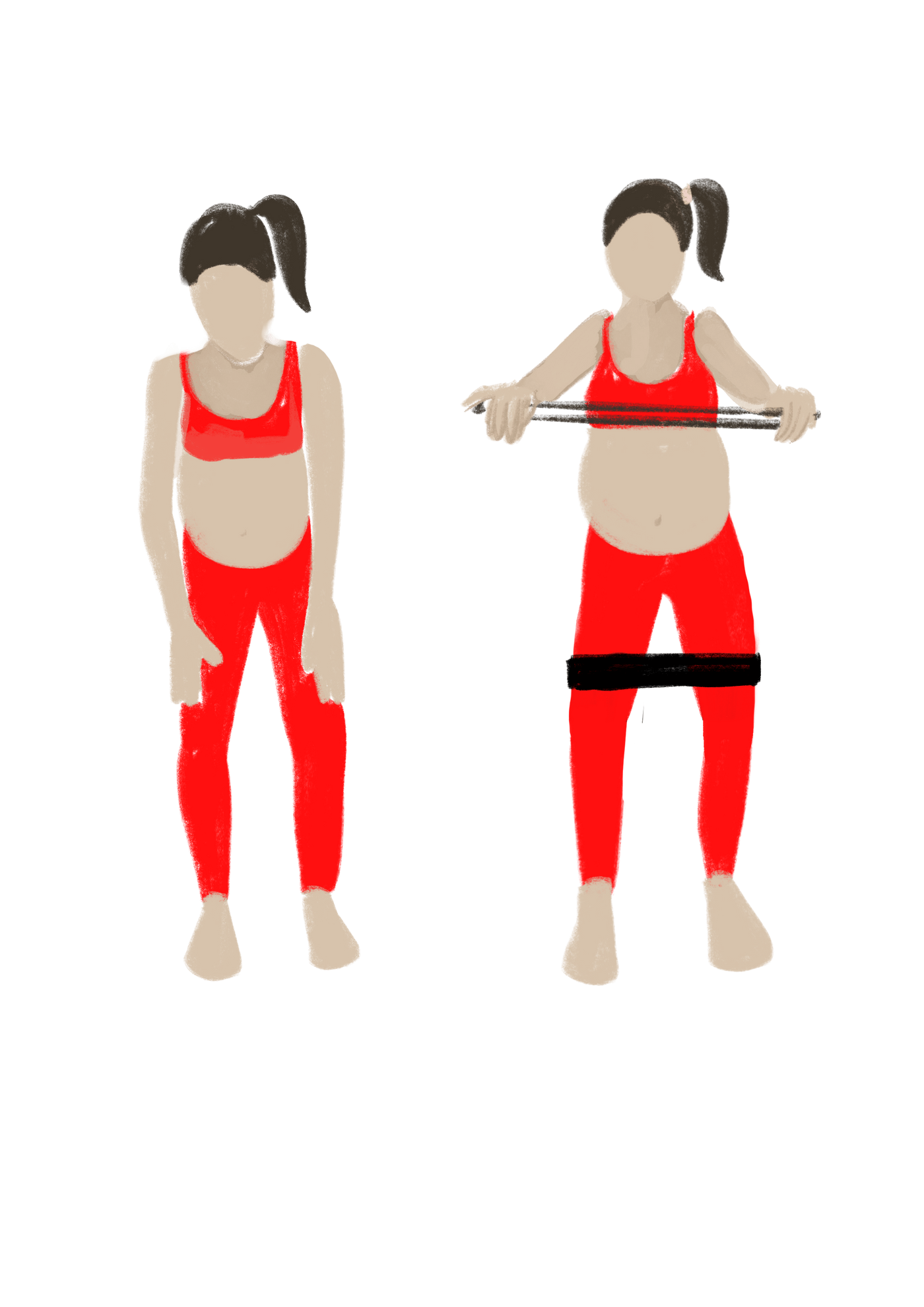
@Nina Sophie Gekeler
1.) Easy chair pose (Utkatasana) and variations
Take a ball between your knees while sitting on a chair. Squeeze the ball ten to 20 times, always exhaling as you do so. Keep your spine long, and your knees directly above your ankles. Adjust the intensity as needed!
Next, place the ball between your thighs and repeat the exercise in the same way. Ensure good, even grounding in your feet.
For individuals with symphysis pubis dysfunction or instability, these exercises should be part of your daily routine.
To intensify the exercise, move into a chair or a light squat position and also squeeze a ball or block between your legs. Alternatively, use a resistance band. Repeat this motion five to 15 times.
Your arms can remain at your hips or be extended upward or to the sides during the exercise.
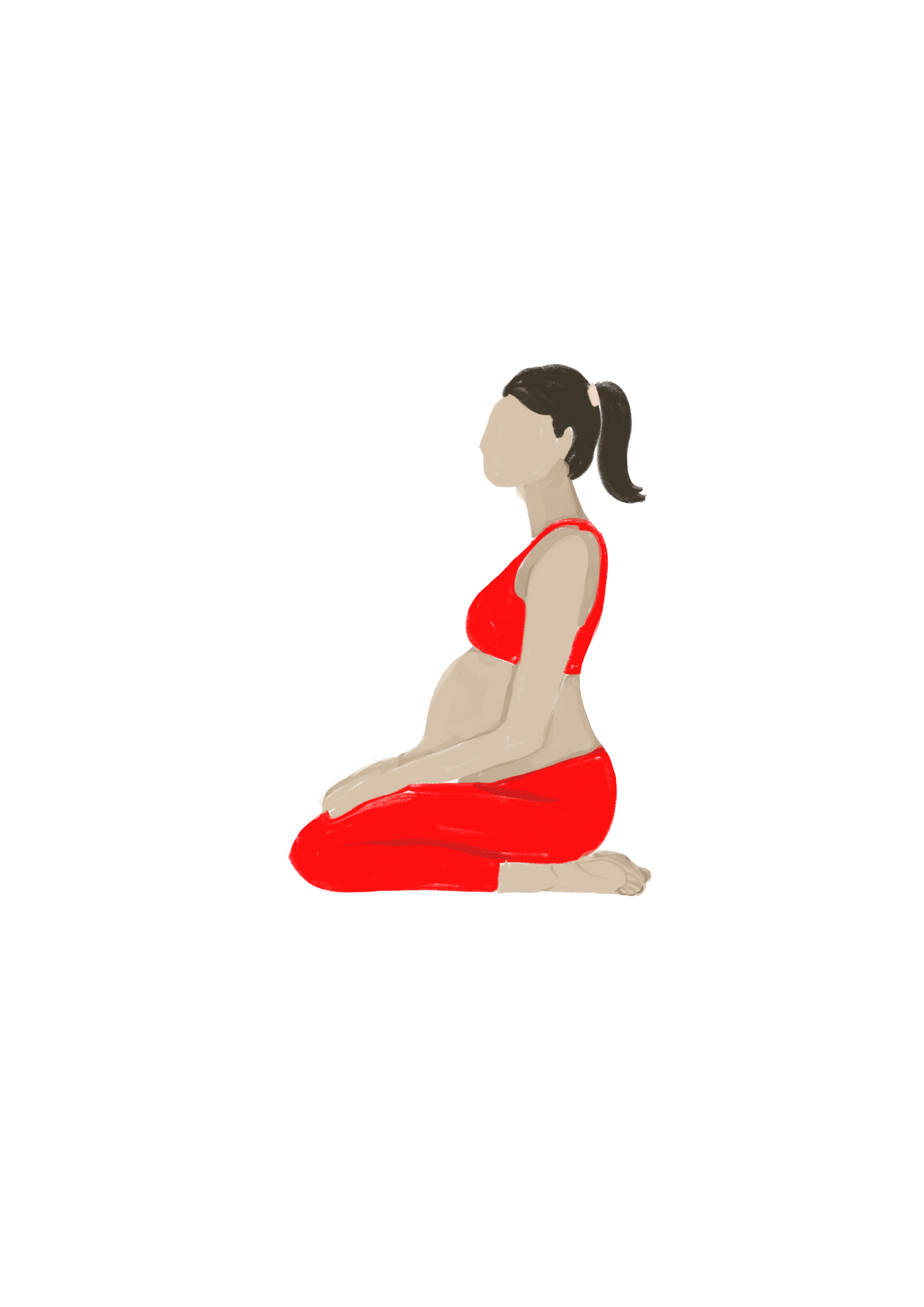
@Nina Sophie Gekeler
2.) Heel sit/kneeling exercise
Come into a heel seat. Find the proper alignment in your pelvis and focus on lengthening your spine.
On the exhale, lift your pelvis, come into a kneeling position, and simultaneously open your arms to the sides. Pay attention to the inner sides of your legs. Inhale as you bring your arms together and lower your pelvis once more. You can pause briefly or maintain a continuous, flowing motion.
Camel pose or Cat & Cow in Hero's pose.
The camel pose works just like Cat & Cow, only you're sitting on your heels on a bolster instead of on all fours. On the inhale, gently arch your back for a subtle heart opening. As you exhale, round your back.

@Nina Sophie Gekeler
3.) Gentle Activation of the Abdominal Muscles Diagonally
Come into the forearm stand. Position your knees under your hips and your elbows under your shoulders, with your feet extended or flexed. You can interlock your hands, and your gaze should be directed towards the mat. Ensure that your spine maintains its natural curvature.
Connect with your baby through a few conscious breaths. On the next exhale, establish a foundational tension and press the right elbow and left knee into the floor - imagine both moving towards your navel. Maintain this tension for a few seconds. Gently release the tension and switch to the opposite diagonal.
Repeat these sets daily, three to ten times.
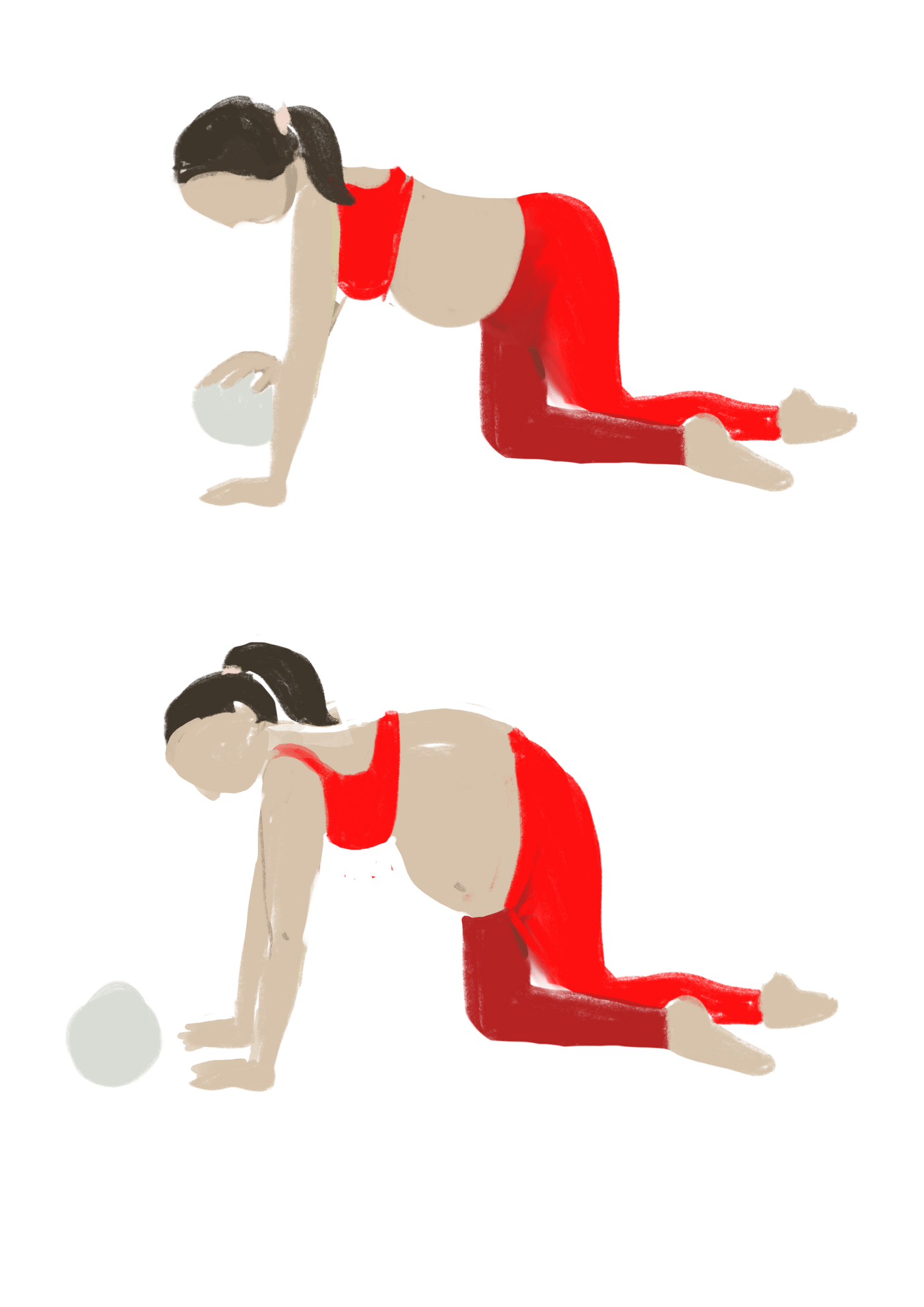
@Nina Sophie Gekeler
4.) Cow Face Pose (Gomukhasana Legs)
Get into the all-fours position, ensuring that your hands are directly under your shoulders, with your toes tucked or feet extended flat and long. Cross one leg tightly over the other, keeping the foot extended. Be aware of the inner sides of your legs.
Begin to flow through Cat & Cow here. Inhale gently lift the chest, and exhale bring your baby a little closer while rounding your back, ensuring your hands and feet are well grounded. Flow through this movement five to 15 times.
Alternatively, you can also place a ball under one hand and press it with your exhale, releasing slightly with your inhale. Important: Always practice on both sides!

@Nina Sophie Gekeler
5.) Strengthening your core muscles in a side-lying position
For optimal pelvic alignment and to avoid uncomfortable pressure on the symphysis, it's recommended to use a nursing pillow (or similar) between your legs.
Lie on your side, extend the lower arm and rest your head on it. Bend your legs, placing a nursing pillow between your knees and thighs. Position the upper hand as a closed fist at chest height in front of you. You can also support the hand on a small ball. Ensure that the upper and lower arms form a right angle.
As you exhale, create a foundational tension and simultaneously press powerfully into the ground with the clenched fist. The idea of hugging the baby with your abdominal muscles helps engage the entire core. Maintain this tension for three to ten seconds. Release the foundational tension slightly with the inhale, and then rebuild it with the next exhale. Repeat this three to ten times.
Afterward, take a short break before switching to the other side.

@Nina Sophie Gekeler
6.) Bridge Pose (Setu Bandhasana)
When the discomfort subsides and your pelvis feels stable enough, transition into bridge pose and squeeze a block/ball between your knees/thighs in the manner outlined above. Again, your knees should be aligned above your ankles.
In the next step, begin to rhythmically lift your pelvis as you exhale, gradually intensifying the pressure on the ball positioned between your legs. Should any discomfort arise, it's advisable to continue with the previous exercises for a few extra days or weeks.
Symphysis loosening and childbirth
"It's crucial to highlight that a loosened symphysis doesn't necessarily call for a cesarean section. Exceptions validate this rule, and it's essential to address this on a case-by-case basis in consultation with a doctor," explains Jessica Strickmann (@erdmutterberlin), a midwife at St. Joseph Hospital in Berlin.
In her experience, many women have reported that the symptoms and discomfort caused by symphysis loosening (softening of the pelvic joints) become less pronounced or disappear entirely during childbirth. This phenomenon can be attributed to the redirection of focus by both body and mind as the baby descends deeper into the pelvis, temporarily restoring tension and stability to the pelvic girdle.
"However, whether the symphysis is loosened or not, childbirth involves movement, and women should always listen to their intuition," Jessica explains.
If the pressure gets too intense, the experienced midwife can recommend positions that will alleviate the strain, such as the deep knee-elbow plank or Tabletop Pose. Furthermore, finding relief can involve using warmth and performing gentle exercise in water. Rest after childbirth is essential, and targeted therapy is crucial, particularly when keeping future pregnancies in mind. The length of postpartum symptoms varies individually, as noted by Strickmann. We wish you and your baby all the best!
Warm regards,
Sabine
Pelvic Floor Exercises
Course
YES YOU ARE Online Yoga
At YES YOU ARE, Sabine not only offers great content on the topics of self-care during pregnancy, childbirth, and everyday life, but also great online courses. We can't recommend her enough.
